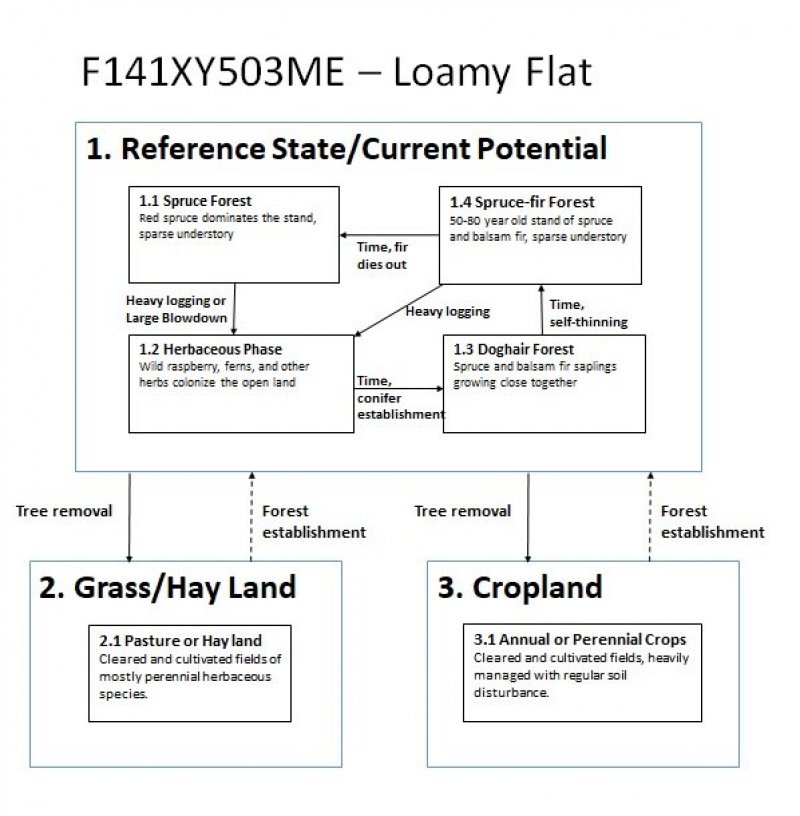
Natural Resources
Conservation Service
Ecological site RX141X503
Loamy Flat
Last updated: 10/03/2024
Accessed: 12/22/2025
General information
Provisional. A provisional ecological site description has undergone quality control and quality assurance review. It contains a working state and transition model and enough information to identify the ecological site.
MLRA notes
Major Land Resource Area (MLRA): 141X–Tug Hill Plateau
MLRA 141 is entirely in New York and makes up about 1,173 square kilometers (3,037 square kilometers). It consists of a relatively small but unique upland that lies just off the eastern end of Lake Ontario and west of the Black River Valley and Adirondack Mountain region. It is essentially a north- and east-facing glaciated cuesta scarp and is underlain by thick Wisconsin till and small areas of outwash. Most of the plateau is woodland, so forestry and recreation are the primary uses, but small isolated dairy operations and hobby farms are located around the perimeter.
The area is bordered on the east by the Black River Valley, on the north by the St. Lawrence Lowland, on the west by the Ontario Lowland, and on the south by the Upper Mohawk Valley. The northern and eastern boundaries of MLRA 141 are distinct where they contact the physiographically dissimilar southwestern part of MLRA 142 (St. Lawrence-Champlain Plain). The western and southern boundaries are also distinct where they contact the physiographically dissimilar MLRA 101 (Ontario-Erie Plain and Finger Lakes Region).
Ecological site concept
This site occurs on flat till plains and ground moraines at elevations between 120 and 2,500 feet. It has a seasonally-high water table, from November through May, that is within 12 inches of the soil surface. From June through October the water table often drops below 12 inches except following large rain events. This site may exhibit pit and mound topography from a history of blowdowns that excavate pits as tree roots tip up and deposit mounds of soil next to the pit.
Soils of this site are poorly- and somewhat-poorly-drained complexes of lodgment till characterized by a densely-compacted layer 10-30 inches below the surface. This dense layer is hard to dig through and often has about 15 percent rock fragments by volume). Importantly, it perches water in the upper soil layers, resulting in redoximorphic features near the soil surface. These are mineral soils, but they may have an layer of mucky peat material on the surface, particularly in poorly-drained depressions.
This site is dominated by red spruce, often with balsam fir occurring in younger patches. Understory is typically sparse, though wild raspberries and other early seral species may occupy large areas when trees are removed by logging, blowdowns, insects or disease.
This site is often managed for spruce-fir timber products, and as such may produce more fir than spruce in a managed state. However, historically these sites were likely dominated by red spruce with a limited understory.
Associated sites
| RX141X305 |
Wet Loamy Flat Wet Loamy Flat ecological sites may be adjacent to or transition into Loamy Flat ecological sites under certain environmental conditions and constraints. |
|---|---|
| RX141X501 |
Loamy Slopes Loamy Slopes ecological sites may be adjacent to or transition into Loamy Flat ecological sites under certain environmental conditions and constraints. |
| RX141X502 |
Loamy Till Toeslope Loamy Till Toeslope ecological sites may be adjacent to or transition into Loamy Flat ecological sites under certain environmental conditions and constraints. |
Similar sites
| RX141X305 |
Wet Loamy Flat Wet Loamy Flat ecological sites may have similar vegetative composition, soil properties, and situated on similar physiographic sites as Loamy Flat ecological sites, increasingly so under periods of drought |
|---|---|
| RX141X501 |
Loamy Slopes Loamy Slopes ecological sites may have similar vegetative composition, soil properties, and situated on similar physiographic sites as Loamy Flat ecological sites. |
Table 1. Dominant plant species
| Tree |
(1) Picea rubens |
|---|---|
| Shrub |
Not specified |
| Herbaceous |
Not specified |
Legacy ID
F141XY503NY
Click on box and path labels to scroll to the respective text.
